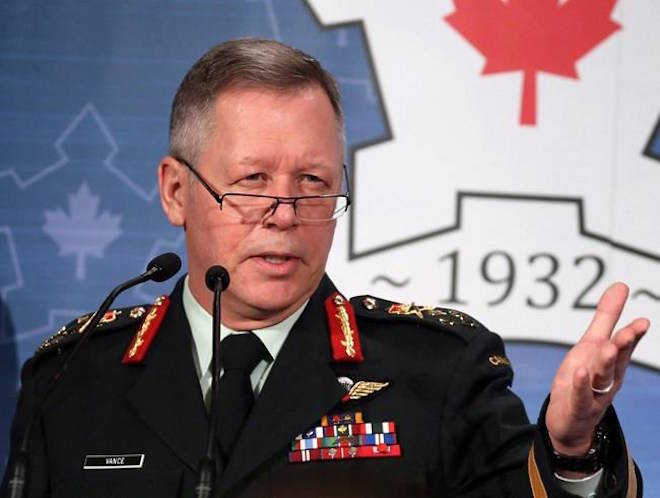The Canadian military has been getting heavier up top and not in the muffin sort of way.
New figures show the ranks of the Canadian Forces’ senior brass have been growing at a much faster rate than the rest of the military over the last 15 years as dozens of generals and admirals have been added.
How much faster? There were 130 generals and admirals in January 2018 compared with 81 during same month in 2003 — a 60 per cent increase over a period in which the rest of the military grew by less than two per cent.
Defence chief Gen. Jonathan Vance stood by the additional brass in an interview on Wednesday and said he plans to grow the senior ranks even more in the coming years in response to new demands and challenges.
“The number of general officers in militaries is not a direct reflection or correlation to the number of people you have in your military,” he told The Canadian Press. “We don’t grow generals because we want more generals.”
Defence experts are divided over the rapid rate of expansion, with some saying it is necessary and others warning about the potential draw on resources from other parts of the military, particularly in terms of combat readiness.
One high-profile review conducted in 2010 by then-lieutenant-general Andrew Leslie, now a Liberal MP and parliamentary secretary for Canada-U.S. relations, specifically called for a reduction in senior military positions.
“Initiatives to reduce overhead should target the disproportionate increases in senior management … aiming to restore civilian and military (executive) positions to roughly 2004 levels,” Leslie wrote.
Vance pushed back against suggestions the Canadian Forces is in danger of getting a brass bulge, saying there have been important changes over the past 15 years that require more generals.
For example, he said, Canada has deployed more senior officers to act as liaison officers with various U.S. and foreign commands in response to evolving threats and the need for greater understanding of what is happening overseas.
New priorities have also emerged with regards to space and cyber operations, while Vance said he has specifically appointed senior officers to manage sensitive personnel files such as sexual misconduct and veterans’ issues.
“So those are positions that get filled as a result of how it is that we want to improve our own performance in a force that’s growing or has gotten new needs,” he said.
“I put a general officer in a place where I need a general officer. And there are a number of factors that lead to that. It’s not always how many people are you leading. It might be the job that you’re doing.”
Related: Media gets hands-on training with the Canadian military
Defence analysts were largely united in their belief that some type of growth at the top of the military over the past 15 years was to be expected — and even necessary.
“The business of defence has become increasingly complex over the last 20 years,” Canadian Forces College professor Eric Ouellet said in an email. “So, there is a need for more ‘management’ and therefore more (senior officers).”
But David Perry of the Canadian Global Affairs Institute was among those who questioned the extent of the “rank creep,” especially since the numbers continued to climb even as the Harper government cut the Forces earlier this decade.
Many units were forced to park vehicles or cut training as they faced budget reductions of up to 15 per cent, which has only been reversed in the past couple of years.
“I’m sure there are defensible explanations for all of them,” Perry said of the continued increase in senior officers.
“It’s just when you step back and look at 50 positions and that kind of percentage increase which vastly exceeds the overall increase in the size of the force, then it’s a little bit harder to rationalize the collective picture.”
Related: First responders not prepared enough for the mental traumas
Lee Berthiaume, The Canadian Press



